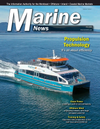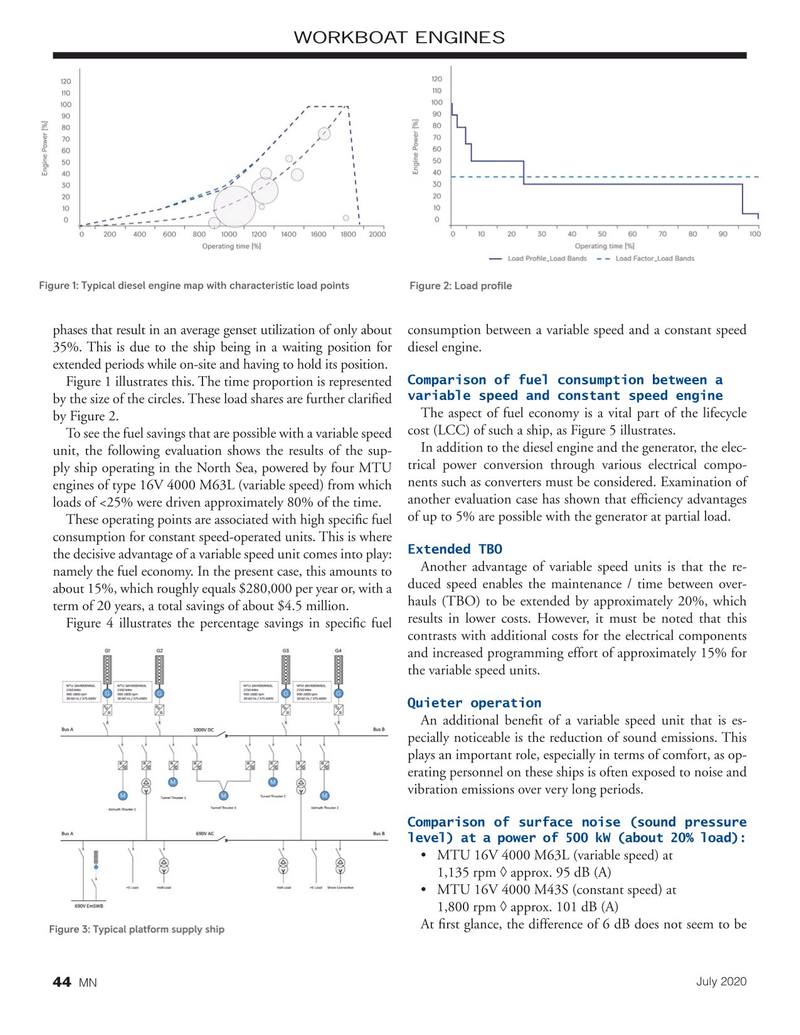
Page 44: of Marine News Magazine (July 2020)
Propulsion Technology
Read this page in Pdf, Flash or Html5 edition of July 2020 Marine News Magazine
WORKBOAT ENGINES phases that result in an average genset utilization of only about consumption between a variable speed and a constant speed 35%. This is due to the ship being in a waiting position for diesel engine.
extended periods while on-site and having to hold its position.
Comparison of fuel consumption between a
Figure 1 illustrates this. The time proportion is represented variable speed and constant speed engine by the size of the circles. These load shares are further clari?ed
The aspect of fuel economy is a vital part of the lifecycle by Figure 2.
To see the fuel savings that are possible with a variable speed cost (LCC) of such a ship, as Figure 5 illustrates.
In addition to the diesel engine and the generator, the elec- unit, the following evaluation shows the results of the sup- ply ship operating in the North Sea, powered by four MTU trical power conversion through various electrical compo- engines of type 16V 4000 M63L (variable speed) from which nents such as converters must be considered. Examination of another evaluation case has shown that ef?ciency advantages loads of <25% were driven approximately 80% of the time.
These operating points are associated with high speci?c fuel of up to 5% are possible with the generator at partial load.
consumption for constant speed-operated units. This is where
Extended TBO the decisive advantage of a variable speed unit comes into play:
Another advantage of variable speed units is that the re- namely the fuel economy. In the present case, this amounts to about 15%, which roughly equals $280,000 per year or, with a duced speed enables the maintenance / time between over- hauls (TBO) to be extended by approximately 20%, which term of 20 years, a total savings of about $4.5 million.
Figure 4 illustrates the percentage savings in speci?c fuel results in lower costs. However, it must be noted that this contrasts with additional costs for the electrical components and increased programming effort of approximately 15% for the variable speed units.
Quieter operation
An additional bene?t of a variable speed unit that is es- pecially noticeable is the reduction of sound emissions. This plays an important role, especially in terms of comfort, as op- erating personnel on these ships is often exposed to noise and vibration emissions over very long periods.
Comparison of surface noise (sound pressure level) at a power of 500 kW (about 20% load):
UÊMTU 16V 4000 M63L (variable speed) at 1,135 rpm ¡ approx. 95 dB (A)
UÊMTU 16V 4000 M43S (constant speed) at 1,800 rpm ¡ approx. 101 dB (A)
At ?rst glance, the difference of 6 dB does not seem to be
July 2020 44 MN

 43
43

 45
45
